Recently, while on a trip to Africa, I was fortunate enough to really observe more ‘big cats’ than I had ever seen before. I often marvel at how similar the behaviors of my own cats are to the behaviors of their wild cousins like lions, leopards and cheetah. Clearly some behaviors are learned from ancestral cats and genetically woven into the fiber of these amazing animals both wild and domestic. Here are 5 ways big cats are just like yours:
1. Big or small, cats like to rest
Ever notice how much time your cat spends sleeping or resting? In Africa, I came upon a family of cheetahs languishing in the sun just a few feet from the road. I sat there watching them do nothing for about an hour. What’s the reason for all this sleeping? According to Ohio State University, “Cats don’t have the sleep/wake cycle that we and many other animals have. This is because cats in the wild need to hunt as many as 20 small prey each day; they must be able to rest between each hunt so they are ready to pounce quickly when prey approaches.” Clearly, our domestic cats have held on to these unique traits.
Because all cats sleep so much, they often wake up and move to a new spot just a few feet away perhaps for a better view but more likely to exercise their muscles and stretch before resuming their horizontal position. I witnessed the cheetahs do just this, relaxing in the sun until for some unknown reason they stood up, stretched and moved to another sunny spot.
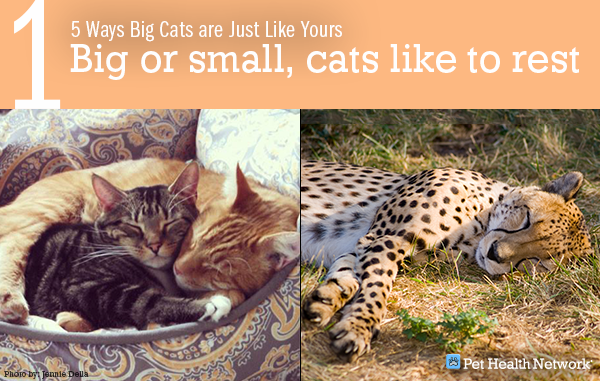
Photo credit: Jennie Della
Recently, while on a trip to Africa, I was fortunate enough to really observe more ‘big cats’ than I had ever seen before. I often marvel at how similar the behaviors of my own cats are to the behaviors of their wild cousins like lions, leopards and cheetah. Clearly some behaviors are learned from ancestral cats and genetically woven into the fiber of these amazing animals both wild and domestic. Here are 5 ways big cats are just like yours:
2. Big or small, cats like to groom
The group of cheetah I found in Africa was clearly a single female with her four cubs. Just a few weeks before there had been five but I was told one had seemingly vanished following a large grass fire. The youngsters explored the immediate area and climbed rocks vying for the best line of sight. They tussled like kittens and groomed each other exactly as my cats do.
If your cats are like mine, one of their primary activities is grooming. That amazing tongue was in part designed as a combined washcloth, comb and hairbrush. Grooming serves to keep wild cats clean and free of food or blood that would attract flies. The cheetah cubs cleaned themselves to remove blood from a recent kill. By keeping themselves clean they also reduced their scent, which might alert a range animal of danger. Additionally grooming one another (allogrooming) serves as a sign of respect and affection and may help maintain peace in the group. I frequently see our domestic cats grooming one another for these reasons.
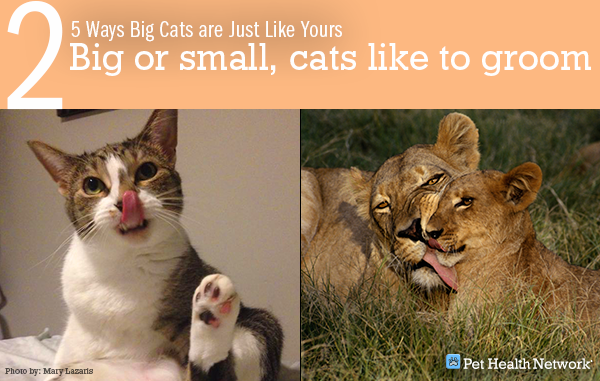
Photo credit: Mary Lazaris
Recently, while on a trip to Africa, I was fortunate enough to really observe more ‘big cats’ than I had ever seen before. I often marvel at how similar the behaviors of my own cats are to the behaviors of their wild cousins like lions, leopards and cheetah. Clearly some behaviors are learned from ancestral cats and genetically woven into the fiber of these amazing animals both wild and domestic. Here are 5 ways big cats are just like yours:
3. Big or small, cats love heights or at least the perception of heights
Another day in Africa we came upon a leopard that had been sent scurrying up a tree by a pride of lions. He was simply in the wrong place at the wrong time. I suspect he was a bit embarrassed at being treed.
Domestic cats also love to sit up high where they can observe their surroundings as well as be let alone. Big cats often climb a tree for a vantage point, to protect their kill from thieving predators and of course to get away from danger. Some cats are excellent climbers while some are weak climbers. The important thing to remember is that domestic cats have these same instincts and we need to provide them with climbing choices.
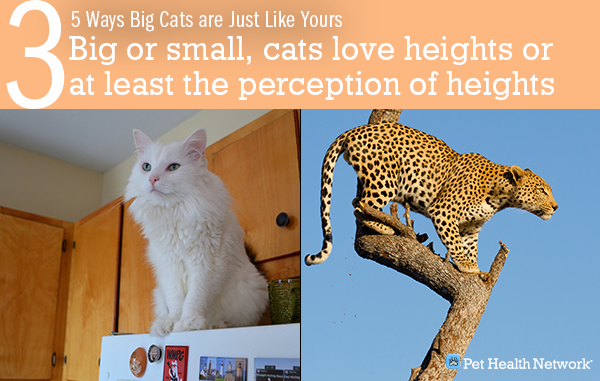
Recently, while on a trip to Africa, I was fortunate enough to really observe more ‘big cats’ than I had ever seen before. I often marvel at how similar the behaviors of my own cats are to the behaviors of their wild cousins like lions, leopards and cheetah. Clearly some behaviors are learned from ancestral cats and genetically woven into the fiber of these amazing animals both wild and domestic. Here are 5 ways big cats are just like yours:
4. Big or small, cats are principally carnivores
In Africa I came upon a small group of lions. Lazing in the tall grass they were nearly undetectable until, that is, a group of unaware warthogs appeared out of the ground and triggered a bit of a standoff between themselves and the lions. It was a very warm day and the lions really weren’t interested in running (especially because they looked pretty well fed already). However, they fell into their instincts and worked together to slowly surround the warthogs. When the pigs bolted the lions relaxed and you could almost hear them say, ”We could have had them.” Then they stretched, yawned and went back to sleep.
Though they consume grasses from a variety of sources, wild cats naturally prefer meat. Domestic cats too are carnivores and the principal ingredients in their food should be meat based. There are no vegan cats and so in spite of our potential personal desire to pursue a meat-free diet, please don’t force your cat to live without meat. Click here to learn more about the dangers of a feline vegetarian diet.
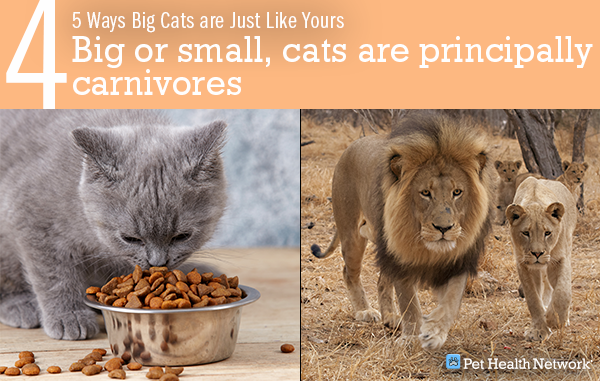
Recently, while on a trip to Africa, I was fortunate enough to really observe more ‘big cats’ than I had ever seen before. I often marvel at how similar the behaviors of my own cats are to the behaviors of their wild cousins like lions, leopards and cheetah. Clearly some behaviors are learned from ancestral cats and genetically woven into the fiber of these amazing animals both wild and domestic. Here are 5 ways big cats are just like yours:
5. Big or small, cats will hunt
You may have noticed a common theme by now. Just as a mother cheetah will teach her cubs to hunt, lions can’t resist practicing the hunt even when they’re full.
Hunting and predatory behavior skills are learned skills that may begin with chasing a blowing leaf or a butterfly only to graduate to a small prey animal and ultimately to hunting larger animals.
Our domestic cats are not often forced to hunt for their lunch, but they enjoy few things more than chasing a ball, feather or laser light across the floor. My own cats are fascinated by insects and the occasional gecko that finds its way into the house. These hunting expeditions keep them alert and stimulated. They also provide an occasional mid-day snack.
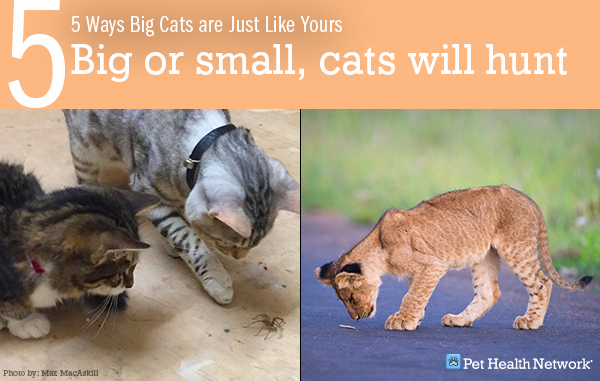
Photo credit: Max MacAskill
Next time you are enjoying the activities of your own cats think about their ancestors and the behaviors they have in common. And remember that your great cat comes from a noble lineage.
If you have any questions or concerns, you should always visit or call your veterinarian -- they are your best resource to ensure the health and well-being of your pets.
